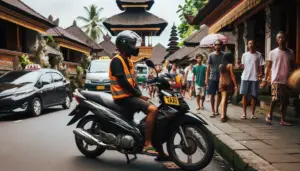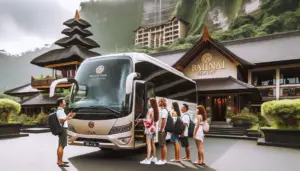TRANSPORTATION IN THE BALI
Known as the famed Island of the Gods, Bali entices visitors from across the globe with its rich culture, surf beaches, and lush interior. Located just off the coast of Indonesia, Bali strikes the perfect balance of secluded island vibes while still being accessible for international travellers.
A well-connected airport provides easy access to Bali from major transportation hubs worldwide. Once on the island, a variety of options help visitors effectively navigate between Bali’s beach towns, rice terraces, temples, and more hidden gems. From flights and boats to buses, trains, and taxis, transportation in Bali caters to all budgets and needs. Read on for an overview of how to reach Bali as well as the best ways to get around this magnificent tropical island.
Getting to the Bali
Bali is easily reached by air through Ngurah Rai International Airport, with direct flights available from major hubs across Asia and Australia. Travellers can also access Bali by sea from neighbouring islands, though flying is quicker and more convenient. The island’s accessible airport makes getting to Bali smooth for international visitors.
By Air
The vast majority of visitors fly directly to Bali through Ngurah Rai International Airport (DPS), located 13 km south of Denpasar.
As Indonesia’s second-busiest airport, it offers easy connections from major airline hubs across Asia and the Middle East like Singapore, Kuala Lumpur, Hong Kong, Seoul, and Dubai on carriers like Singapore Airlines, Qatar Airways, and Garuda Indonesia.
Many European cities like London and Paris also offer direct seasonal flights. Flight times average 15-18 hours from North America and 12 hours from Australia when factoring in layovers. The airport is well-serviced by taxis, hotel transfers, and shuttle buses for onward travel.
By Sea
Reaching Bali by sea is possible but much lengthier compared to air travel. Public ferries connect Bali to Java and Lombok, though only recommended for adventurous travellers due to long journey times and basic conditions.
Luxury boats and yachts can also be privately chartered to Bali from nearby islands like Java or Lombok. While costly, this offers a shorter and more relaxed journey directly to Bali’s beaches and harbors.
Travelling within the Bali
Once in Bali, visitors can easily explore the island’s famous beaches, verdant jungles, and cultural sites thanks to a range of transportation options.
Well-paved roads circumnavigate Bali and provide access to coastal towns and interior villages by private car, motorbike, or bus.
Traditional bemos minibuses and metered taxis conveniently shuttle visitors between main tourist areas. Fast boat services link seaside towns and dive sites across Bali and neighbouring islands.
Whether travelling on a budget or seeking comfort and convenience, Bali’s range of transportation caters to all needs for journeying across this magical island.

Taxi
Taxis are readily available for getting around the main tourist areas of Bali. Blue Bird and Taksi Bali are the most reputable metered taxi companies. Fares start at around 10,000 IDR ($0.70 USD) for short trips and increase based on distance traveled. Taxis can be flagged down on the street in areas like Kuta, Seminyak, and Ubud, or called ahead for pickup service. Drivers generally know the major destinations well, but it helps to have the address written in Indonesian. Taxis provide a comfortable and cost-effective way to travel between hotels, restaurants, shops and attractions around Bali’s busiest hubs. Just be sure to negotiate the fare before departing if the driver does not use a meter to avoid any pricing issues.

Scooter Rentals
Renting a motorbike or scooter provides an adventurous and low-cost way to explore Bali’s winding roads and hidden gems at your own pace. Small shops along major roads in tourist areas rent scooters for 50,000-70,000 IDR ($3-5 USD) per day. Larger rental companies like Bali Motorbike Rental Company include newer models and extras like surfboard racks and GPS units for slightly higher prices. A valid driver’s license is typically required. While convenient, driving a scooter in Bali can also be dangerous for inexperienced riders. Roads outside major cities are not always well-maintained and locals often drive aggressively. However, taking scenic coastal routes or cruising through rice paddies on a scooter lets adventurous travellers discover Bali’s magic. Observing road rules and wearing a helmet is a must.

Motorbike Taxi
For quick, cheap rides around town, motorbike taxis called ojeks are ubiquitous in Bali. Drivers wait on busy streets in tourist areas to offer rides, or can be booked through apps like Gojek. Ojek fares are extremely low, usually just a few dollars for short distances around towns and villages. While affordable and convenient, ojek rides can also feel perilous weaving through traffic. Always negotiate the price before hopping on the back of a motorbike taxi. Wearing a helmet is a must for safety. Though not the most comfortable way to get around, ojeks allow budget travelers to zip to their destination like locals do. Taking an ojek through rice fields or down small village roads provides an exhilarating local experience.

Ride-hailing Apps
Getting around Bali is made even easier by using popular ride-hailing apps like Gojek and Grab. Available for download on smartphones, these apps allow travellers to digitally hail rides from registered drivers of cars, motorbikes, and scooters. Ride types range from standard air-conditioned cars ideal for small groups to individual seats on motorbikes for solo travellers. Fares are shown in advance and paid directly through the app – no cash is handled. While pricier than haggling with traditional taxis or ojeks, apps provide added security, convenience, and peace of mind. They also help travellers avoid hassles for non-Indonesian speakers. With the tap of a button, visitors can smoothly arrange rides to restaurants, attractions, or anywhere across the island 24/7.

Public Bus
Public buses provide an extremely affordable transportation option around Bali with fares starting under $1 USD. Air-conditioned coaches run by Perama Tours directly connect tourist destinations like Kuta, Ubud, and Candidasa. Smaller public buses run by the provincial government along routes connecting Denpasar to other parts of Bali are older and more crowded but even cheaper. Paying close attention to your stop is advised. While buses take more time with frequent stops and meandering routes, they allow visitors to mingle with locals and take in the island’s daily life. Buses generally operate from early morning until evening. Schedules are not strictly adhered to, so factor in extra time when relying on public buses to reach your destination in Bali.

Private Bus
For ultimate convenience and flexibility, visitors can charter their own private bus and driver for the day or duration of their Bali trip. Many transportation companies offer chartered buses ranging from mini-buses ideal for small groups to full-sized coaches fitting 40+ people. Travelers can customize their itinerary to visit exactly where they want at their own pace with stops for meals and sightseeing. Drivers double as knowledgeable local guides about the island. Chartering a private bus provides door-to-door service and complete privacy for families, weddings, corporate outings or other large gatherings. Rates typically range from $50-100 per day depending on group size, vehicle specifications and distance covered. Chartering a private bus lets travellers experience Bali on their own terms.

Car Rental
For complete freedom exploring Bali’s beaches, jungles and villages, renting a car allows travellers to cruise the island on their own schedule. Small local agencies and international brands alike offer car rentals starting around $30 USD per day for basic models. Rental outlets are located at the airport, across main tourist hubs like Kuta and Legian, as well as directly from hotels. Drivers must present a valid license from their home country along with a credit card for the security deposit. While convenient, driving requires extra caution in Bali – roads can be narrow with locals obeying informal rules. Using a GPS navigation device helps navigate unfamiliar routes. With a rental car, visitors can chase waterfalls in Munduk, find hidden rice terrace vistas, and have the flexibility to stop wherever captures their eye across Bali.


